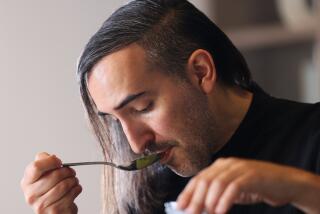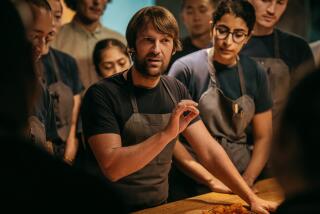Neurotic, table for one
YOU’RE in a fine dining establishment and notice they offer calf’s liver. You have never tried calf’s liver. You ought to try calf’s liver, you tell yourself. Experimentation is good. But wait, didn’t this whole discussion begin on the seemingly emphatic point that calf’s liver is not something you want? Don’t you want the salmon? Isn’t that what you and your head agreed on not two minutes ago? Yes, but you’ve had the salmon at this dining establishment, why not try the calf’s liver? And yet, aren’t you trying to eliminate “shoulds” from your life?
Now here comes the waiter. He’s heading straight for your table! There’s a chance he’s just going to ask how work’s going, but you’ve been eating out for years, and usually that’s not what a waiter wants to know. He wants to know what you’ll have.
“Calf’s liver,” you say, beginning to perspire.
Do you have Order Panic Disorder? I ask because I find myself increasingly fearful of menus and unable to deal with the decisions involved when eating out (those who know me are chuckling at the term “increasingly”).
I don’t think Order Panic Disorder is a medical term, by the way, it’s just my self-diagnosis. But it’s a real problem. The other morning I was in a Jamba Juice, reading the big board: “Cranberry Craze: cranberry juice blend, raspberry sherbet, frozen strawberries, nonfat plain yogurt ... Orange Berry Blitz: 100% pure orange juice, pineapple sherbet, frozen strawberries, frozen blueberries ... “
I stood there, a tad confounded. I began to cross-reference what had sherbet and what had yogurt, and which meal-drink might provide the best ratio of berry content, and then it was on to whether I’d been getting enough Vitamin B lately.
Not surprisingly, it all began to feel like work, an early warning sign of Order Panic Disorder. The only thing I knew deep down was that I didn’t want a “boost.” A boost? What exactly are we talking about here?
In the end I went with the Strawberries Wild. The taste reminded me of what a friend says after every movie he sees: “It was cute.” He says this whether he’s just come out of “The Passion of the Christ” or the third “Rush Hour” picture. He sees everything.
This friend, by the way, also has no trouble with restaurant menus, while I am the sort of person who needs to know what other people at the table are having, like the president polling his Cabinet. (“Condi, what do you think of that sea bass special? Rummy, you going with the New York cut again?”)
When we go to Jerry’s Deli or a place with a similarly discursive list of choices, my friend, who did much, much better than I did on the SAT, cuts to the quick and puts the menu down while I bounce around figuring out which sandwich or salad I want. Eventually this begins to take on the urgency of picking out a country to bomb. In my head, it sounds roughly like this: “Chopped salad ... half a turkey sandwich and the pea soup ... Libya!”
“A few decades of research has made it clear that most people are terrible choosers -- they don’t know what they want, and the prospect of deciding often causes not just jitters but something like anguish,” the New Yorker magazine said recently in a review of a new book called “The Paradox of Choice.”
The book, by Swarthmore social scientist Barry Schwartz, expounds on the theory that the more choices we’re given, the less free we feel to choose.
At a supermarket, for instance, the incredible array of salad dressings, rather than emboldening us to choose exactly what we want, reduces us to inaction. This “paradox of choice” is not just limited to menus and supermarket shelves. It also helps explain why so many people in their 20s and 30s are flummoxed by the prospect of choosing a career and a mate.
They have too many choices and end up in a state of paralysis, waiting for the “best” option to come along, which in itself is a fallacy, since we’re not necessarily good at predicting what we want.
This is distressing but not surprising news. It is also why, when I eat now, I have been experimenting with a kind of radical therapy. Me and a menu meet, look each other over briefly, and then I choose, allowing myself only a cursory amount of agonizing. If necessary, I repeat a mantra: “None of this will make you happy, none of this will make you happy.”
Of course, the next 20 minutes is still spent regretting my choice, followed by the arrival of the food, which in turn is followed by longing looks at what my friend has ordered and how content he seems. Me and my stupid food, we sit there, bored with each other. We’re like the unhappy couple, while my friend and his food are the great match. But we’ve found each other, me and chef salad, chopped, please, all turkey but no ham, blue cheese dressing on the side. And this, in its own way, has to be a blessing.
Paul Brownfield can be reached at paul.brownfield@latimes.com.
More to Read
Eat your way across L.A.
Get our weekly Tasting Notes newsletter for reviews, news and more.
You may occasionally receive promotional content from the Los Angeles Times.








